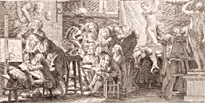|
Artistic Training in 18th-Century France
Becoming an artist in the 18th century required years of rigorous training. As a teenager, the aspiring artist began by tracing anatomical details from prints and drawings. With enough success he (rarely she) could move on to tracing entire two-dimensional figures and then to sketching plaster casts of ancient sculptures, an activity shown in this engraving. Eventually he might graduate to drawing the live model. In France, the elite Royal Academy of Painting and Sculpture had a monopoly on the life-drawing class. The Academy also offered instruction in anatomy, perspective, and facial expression. Painters studied with private teachers to learn their medium. Aspiring history painters, such as Jacques-Louis David, also learned about architecture, language, literature, and mythology. Annual contests at the Academy determined students' pecking order, even down to the order in which they filed into the life-drawing class. The most favored students might win the Prix de Rome. Prizewinners who showed great promise could exhibit in the Academy's official exhibition, known as the Salon. The Salon was followed avidly by press and public and could make or break a young artist's reputation. |
